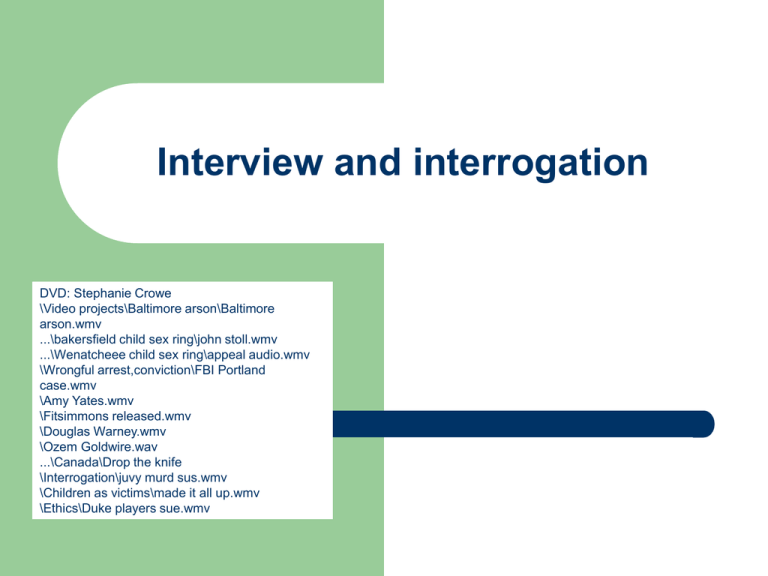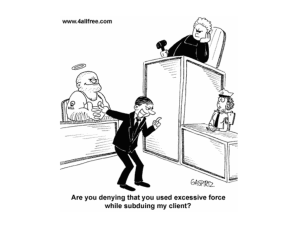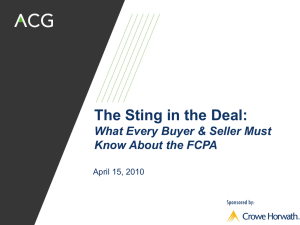
Interview and interrogation
DVD: Stephanie Crowe
\Video projects\Baltimore arson\Baltimore
arson.wmv
...\bakersfield child sex ring\john stoll.wmv
...\Wenatcheee child sex ring\appeal audio.wmv
\Wrongful arrest,conviction\FBI Portland
case.wmv
\Amy Yates.wmv
\Fitsimmons released.wmv
\Douglas Warney.wmv
\Ozem Goldwire.wav
...\Canada\Drop the knife
\Interrogation\juvy murd sus.wmv
\Children as victims\made it all up.wmv
\Ethics\Duke players sue.wmv
Interview process
What is a “witness?”
Anyone with personal knowledge (saw, heard, felt,
smelled) of any fact or circumstance, including things
that happened, words said, the presence of
documents and other tangible items, that can help
prove or disprove that an offense was planned or
committed, that someone participated or had a
motive or opportunity, or that physical or
documentary evidence exists
A person is still considered a “witness” if what they
have to say furnishes investigative leads but is
inadmissible in court
Conventional interview
Warm-up period
– Identify the witness
– Inform the witness about the subject of the interview
– Place witness at ease, reduce anxiety
Main body of interview
– Use open-ended questions (“what happened?”, “what did you see
next?”)
– Phrase questions positively (e.g., “how fast was the car going?”),
not suggestively (“was the car doing about fifty?”)
– Keep questions brief and narrowly focused
– Place questions systematically, if possible in chronological order
Wrap-up
– At the end go over the answers
– Ask if anything was left out
Structured interview –
Frazee three-step process
1.
2.
3.
Respondent tells the story in their own way
–
Take notes
–
Minimize interruptions
–
If must clarify, repeat what the respondent said, phrasing it as a
question
Officer uses notes to guide the respondent in retelling the story
chronologically (step by step)
–
Take notes
–
Maintain a logical sequence
–
Focus on the important aspects (what may be evidence)
–
Challenge respondent when necessary
–
Bring up missed topics but don’t suggest what to say
Officer reads back finalized notes
–
Encourage challenges to your retelling
–
Make corrections and read them back for concurrence
Frazee three-step interview process -- residential burglary -- officer’s report
On _____________ I interviewed Joe (or) Trudy Smith, 123 Elm St., Los
Angeles. He/she said as follows:
Ms. Smith lives at this home with her husband, Joe and their son, Steven.
On _____ she left for work at 8:00 am, locking the house. Her husband had
already left. She returned at 6:00 pm and discovered the burglary. Her son
was present. He supposedly arrived about 5:30 pm, after football practice,
but waited for her to call police.
Ms. Smith observed muddy footprints leading from the living room window,
which was open. The window was not damaged but she does not know if it
had been locked. Their upstairs bedroom was ransacked. Missing property
includes a new Philips DVD changer, value $500, which was kept on a shelf
downstairs, and a jewelry box, normally kept on the bureau, in her upstairs
bedroom. Also missing are items from the jewelry box, including a diamond
cocktail ring valued at $3,000.
Ms. Smith suspects that her son’s friend, Josh, may be involved. Josh is
given run of the house by her son. Ms. Smith believes that Josh has been in
juvenile hall for theft. According to Ms. Smith, Josh is not on the football
team.
Cognitive interview
Purpose is to enhance recall
Technique and its purpose described to the witness
– Be careful not to suggest anything
– Do not stress the witness’s importance
Steps
– Witness describes the physical environment where the
incident took place
– Witness reports his feelings and reactions
– Witness mentions everything they can remember
– Witness recalls events in a different order
– Witness reports incident from another person’s point of view
Legal Issues
Terminology and admissibility
Interview or interrogation?
– Interview a witness / interrogate a suspect
– Legally there is no distinction unless a person is
in custody (i.e., “custodial interrogation” -- see
next slide)
Admission or confession?
– Confession: as to all elements of a crime
– Admission: something less
Custodial interrogation
Miranda v. Arizona (1966)
– Purposes
To discourage police from using coercion
To prevent involuntary confessions
– Requirements: If person is in custody they must be advised of:
Right to counsel (Sixth Amendment)
Privilege against self-incrimination (Fifth Amendment)
When is interrogation “custodial”?
– When freedom of movement is significantly restricted. Stop-andfrisk is inherently custodial.
– U.S. v. Kim (9th. Circuit, 2002): Being detained during a search
warrant can be enough.
– U.S. v. Hayden (9th. Circuit, 2001): It’s what the suspect thinks
that is important
Non-custodial situations
U.S. v. Bassignani (9th. Circuit, 2009): Suspect questioned in a
conference room while officers served a search warrant at his place of
work. Because officers were cordial, told him he wasn’t under arrest
and pressure was low, Court said Miranda warning was not required.
Special rules once judicial process is invoked
– Whether or not subjects are in custody, if formal charges have
been brought (e.g., complaint filed, arrest warrant issued,
indictment returned) subjects must be informed of their right to
counsel before being interviewed outside their attorney’s presence
– In Montejo v. Louisiana (2009) Supreme Court overturned a prior
decision that prohibited such interviews altogether
– Under Massiah v. U.S. (1964) undercover work or surreptitious
surveillance is generally useless once the judicial process is
invoked (target must be informed of right to counsel)
Note: Only exception is that can use such statements for
purposes of impeachment
Voluntariness and “shock the
conscience”
Bram v. U.S. (1897): Confession must be voluntary – not obtained by
direct or implied promise or improper influence, such as the “force of
hope or fear”.
Brown v. Mississippi (1936): Beating some to make them confess (a)
shocks the conscience and (b) makes confessions involuntary.
Ashcraft v. Tennessee (1944): Whether police interrogation “shocks
the conscience” depends on the “totality of the circumstances”.
Rochin v. California (1953): Police behavior that “shocks the
conscience” is a violation of the Due Process clause of the Fourteenth
Amendment. In this case officers choked a suspect who was
swallowing pills, and when unsuccessful had his stomach pumped out.
Frazier v. Cupp (1969). A continuous, “relentless” 36-hour
interrogation is illegal.
Voluntariness/“shock the
conscience” violations
Leyra v. Denno (1954): Defendant, suffering from severe sinus
condition, is relentlessly interrogated. A doctor (really a psychiatrist)
sent in to “help” skillfully breaks down the defendant’s will by, among
other things, telling him how much better he would feel if he
confessed.
Spano v. New York (1959): Defendant confesses to a close friend, a
police cadet. He then confesses again to detectives after being
repeatedly begged by his friend, who says that if the defendant does
not talk he (the cadet) will get in trouble and his wife and kids would
suffer.
Rogers v. Richmond (1961): After prolonged interrogation defendant
confesses when officers threaten to arrest his sick wife. Supreme
Court ruled the confession inadmissible because it was not free and
voluntary, but made under the influence of a promise or threat.
Doody v. Schriro (2008): Relentless twelve-hour, overnight
interrogation of a 17-year old by tag-teams of officers where parents
were not present, Miranda warnings were given but “downplayed,” and
questioning turned “menacing” and “coercive”. Reaffirmed 5/4/2011
Interviewing issues
Interviewing children and juveniles
Blurry line between right and wrong, between reality and fantasy
Children concentrate on the present
– Want to resolve immediate problems
– Don’t think ahead or consider the consequences for others
Easily influenced and manipulated
– Want to please adults
Unsophisticated, little life experience
– Don’t understand the CJ system
– Assume that police and adults will do the right thing
– Don’t understand adult needs and motivations
– Don’t appreciate the seriousness of their situation
Believe that everything will turn out OK once their parents or guardians
become involved
Four-year old lies -- precisely -about an abduction attempt
On 11/20/07 OCSD deputies deployed eight cars
and spent hours searching for a man a four-year old
said tried to kidnap her from a Midway City park.
The girl described her assailant precisely, saying that he had spiked
hair and a dragon tattoo. Deputies placed a neighbor who fit that
description under observation. They also detained another person.
She later said it was all a lie, told because she was upset that her
mother left her alone while she went to see someone.
A Sheriff’s spokesperson said they were stunned that a young child
could give such vivid -- and false -- details:
– "In 28 years in law enforcement, I have never had a 4-year-old
make up a story like this. It says something about what television
is doing to our children."
Perhaps the Sheriff’s Department can send someone to take this
class?
'I felt everyone knew I was lying. But my
parents said, "You're doing fine.
Don't worry." And everyone was saying how
proud they were of me.'
On 10/30/05 the L.A. Times Magazine published a long,
heart-felt apology from Kyle Sapp, who as an eight-year-old
was one of several hundred children who said they had been
forced by the owner and employees of the McMartin
preschool in Manhattan Beach to participate in an untold
number of lurid sex acts.
According to Kyle, it was all untrue. His family was very
dysfunctional and he was always looking for praise. So he
simply told his parents and the interviewers at Children’s
Institute International what they obviously wanted to hear.
He knew that lawyers wanted a consistent account, so he put
a lot of pressure on himself to provide just that.
‘I don’t think they
thought I was
telling the truth,
just that I was
telling the same
stories consistently,
doing what needed
to be done to get
these teachers
judged guilty.’
Youth statements and recantations: who’s on first?
In 2004 an 8-year old girl was
strangled to death in the Georgia
trailer park where she lived. A
troubled 12-year old neighbor boy
confessed. He later retracted his
confession, alleging that police had
relentlessly interrogated him for
several hours. In 1995 he entered
into a plea agreement and received
two years in a juvenile facility.
In February 2006 a mentally disturbed 18-year old said he, not the 12-year
old, was the real killer. This new confession seemed credible because the
victim was heading towards his residence when she disappeared. He also
gave police intimate details of the crime. But then he also recanted.
The victim’s parents are convinced that the 18-year old is the real killer and
have apologized to the 12-year old’s family. The police disagree; however,
a grand jury indicted the 18-year old, leading to the original suspect’s
release. A trial is pending.
2004 Garden Grove drifter: "He grabbed my hair and then he started
pulling me. And that's when I screamed. I tried to go away, and then
my friends were trying to help me, and that's when he started
choking me.“ As Eric Nordmark sat on trial in Santa Ana for molesting
three girls, he was convinced that his accuser had been assaulted by
someone. But he was wrong. In jail since May 2003, Nordmark was
freed after the girls admitted they made it all up to avoid being punished for coming home
late. The girls were prosecuted in juvenile court and will be on probation until age 21.
1984 McMartin case: Interviewing techniques implanted false memories
of sexual abuse into scores of children who attended a Manhattan Beach
day-care. The case soon fell apart. Of the seven employees indicted, only
two were tried and both were acquitted.
The Bakersfield 46: In May 2004 a Kern County
judge declared John Stoll innocent after the man
served eighteen years in prison for allegedly
leading a cabal of Bakersfield child molesters.
The last of forty-six defendants in a string of
put-up cases, Stoll’s luck turned during two
tearful, in-court recantations, including one by a
26-year old man whose false statements sent his
own mother to prison for six years.
The Wenatchee “child sex ring”
Between 1994-5 forty-three adults were arrested on “horrific tales” of sexually abusing
sixty children in Wenatchee. Eighteen were convicted. The investigation was initiated by
Wenatchee police detective Bob Perez and joined by State child protective services.
Prosecutions were based on interviews with the children and confessions obtained by
Perez and his colleagues.
Among those charged with multiple counts of child rape and molestation were several
church members:
• Pastor Robert Roberson and his wife, Connie;
• Honnah Sims, a Sunday-school teacher;
• Harold and Idella Everett, two developmentally
disabled parishioners. They were accused by their
two children, both of whom were living with foster
parents: Detective Bob Perez and his wife
Others arrested and prosecuted include:
Idella Everett
• Carol and Mark Doggett. They were arrested on 1,000 counts of rape after they asked
for police and CPS help in dealing with their troubled son;
• Michael Rose, a laborer, on 336 counts of child rape
And on...and on...and on
Child victim interviews
•
Many of the victims had a history of making “outrageous” claims of sexual
abuse. Others had actually been abused by blood relatives. When they
repeated the same accusations against new foster parents they were
taken at face value.
•
After making inconsistent statements filled with “pornographic fiction” to
investigators, many children recanted. Their recantations were ignored.
•
Twenty-nine children were sent for prolonged stays at Pine Crest, a
seedy Idaho psychiatric hospital that offered special interrogation
techniques.
•
•
•
•
•
The detective and CPS workers routinely threw away interview notes.
Things suspects said were purposely twisted by investigators
Statements favorable to the defendants were withheld from their lawyers
Prosecutors filed charges on literally every case brought to them
Judges rejected defense requests to allow expert testimony about false
memory syndrome
Two kids taken to Pine Crest
Sarah Doggett (r), 16, was forcibly taken to
Pine Crest by CPS officials, who said she was
“suicidal”:
“Why did almost all my treatment at Pine Crest
deal with me having to remember sexual abuse
that never happened?
Jessica Cunningham, 17, had previously spent time at Pine Crest. She was
sent there by her parents for behavioral problems. Jessica said that the
detective and CPS pressed her to say that “my parents did things to me and
to my sisters...and if I didn't, I wouldn't get out of Pine Crest...They had their
own ideas of what happened in my family. When I disagreed and said they
were wrong, they said I was lying. I was hiding the hiding the truth.... I had to
remember. I had to talk. Disclosure would make me feel better. It just never
ended...I was a prisoner....”
Jessica’s mother, Connie, was convicted and got 46 years. She and her
daughter later reunited and now live in California.
Defendant interviews
•
“The more I said I didn’t do any of the things [the detective] said I did the
angrier he got....He told me I was going to jail for the rest of my life or I could
go home, I could have my son back, if I gave him a statement. I said
whatever he wanted me to say, just to have it over....” (Got 16 ½ years)
•
“I asked, ‘can I have an attorney’? He says ‘no, there’s no need for one to
be present because we’re just questioning you.’....I wasn’t sure what I was
signing because I was flabbergasted.” (Alcoholic, IQ of 73)
•
“My state of mind when I signed the confession was that I wanted to get out
of there and get away from him....[The detective told her she was not a
suspect]....I wanted to go home to my own bed, my own house, my own kids.
He made promises that I could go if I just signed. What a liar.” (Woman. As
an infant, she lost a leg to a hog. Plea bargained, got 40 years.)
•
“I kept saying ‘no, no, no, no. I want an attorney.’ But he said ‘you don’t
need one because you are only a witness’.” (Mother of four, barely literate,
had the detective read her the confession. Turned down a plea bargain, was
convicted by jury, got 23 years.)
Outcomes
•
•
•
•
The detective no longer works there
Of the eighteen convicted, all have been released
Most convictions were overturned. Some pleas were accepted and
entered on lesser, “usually unrelated” charges
Many lawsuits were filed by the defendants:
–
In December 1999 the State settled with the Robersons and Honnah
Sims for $850,000
–
In November 2000 Chelan County settled with Roberson, who
previously won over $200,000 in damages from a Federal jury
–
On Sept. 30, 2001, a Spokane County jury found Wenatchee and
Douglas County negligent in the investigation of six plaintiffs, including
Sims and Roberson. They awarded $3 million to Honnah Sims and
her husband.
Play audio
The Murder of Stephanie Crowe
On the morning of January 21, 1998,
Stephanie Crowe, 12, was found stabbed to death
in her Escondido home. None of the other
residents – her parents, grandmother, sister and
brother – said they heard anything during the
night. Police immediately focused on three youths – her brother Michael, 14, and
two friends, Aaron Houser and Joshua Treadway.
Four days later they picked up Michael Crowe. He at first denied having
anything to do with his sister’s death. But during a relentless six-hour session the
next day, in which detectives concocted stories about finding his sister’s blood in
his room, Crowe finally confessed although in a most peculiar
way – by saying that, yes, he did it and that, yes, he was making
it up. Escondido police then picked up Joshua Treadway. After
being threatened with prison and subjected to two grueling
interrogations, including a ten-hour session in which police
administered a voice stress analysis, Treadway said he acted as
a lookout while Crowe and Houser did the deed. Aaron Houser
maintained his innocence throughout.
Certain that the crime was solved, prosecutors pointed to the
three teens’ love of fantasy role-playing games and Michael’s
admitted jealousy of his popular sister. The boys were quickly
indicted. But a judge later threw out all of Crowe’s confession
and most of Treadway’s, ruling that both teens had been
coerced. So the defense dredged up questionable forensic
testimony. “Expert” witnesses offered to testify that a knife
found under Treadway’s bed was “identical” to the weapon
that inflicted the fatal wounds, that the killing could not have
been committed by only one person, and that the words “kill, kill” left on
the victim’s windowsill could have been written by
Michael Crowe. An FBI crime scene profile strongly
suggested that the crime was an inside job.
Still, there were many inconsistencies. To have
participated in the killing Treadway had to have snuck out
of his home in the middle of the night and made the
ten-mile roundtrip journey on foot. It simply didn’t add
up. And there was something else...
Hours before the murder the Crowe’s neighbors
spotted Richard Tuite, a 28-year old schizophrenic
with a record for drug and property crimes. Tuite
had past arrests for burglary, a stabbing and for
leering at young girls and following them home.
Tuite, who was roaming the area, stood on the
victim’s property and looked up at the windows.
But by the time that an officer arrived Tuite was
nowhere to be seen. As the officer left he radioed in that he saw the
Crowe’s laundry-room door closing. The next day officers brought
Tuite to the police station, where they took his clothing and fingernail
scrapings. Tuite was cooperative and was let go.
Defense attorneys examined Tuite’s clothing. Spotting suspicious
stains, they asked they be tested. Detectives, who pooh-poohed Tuite’s
ability to commit the crime, said they did so and found nothing. But
the defense persevered and Tuite’s things were sent for DNA analysis.
Six months after their arrest a judge held over
the three boys for trial as adults. But the judge
warned prosecutors that their evidence was
wholly lacking. He also wondered why Tuite
had been dismissed as a suspect. The boys
were released to the custody of their parents.
In January 1999, as jury selection for the boy’s
trial got underway, the crime lab reported that Tuite’s shirt was
spattered with Stephanie Crowe’s blood.
The boys were freed. Escondido police
were replaced by the Sheriff’s office and
the State Attorney General’s office took
over the prosecution.
In May 2003 Tuite was convicted of
voluntary manslaughter for
Stephanie Crowe’s murder. In August
2004 he was sentenced to thirteen years.
In June 2003 True Crime Publications published
“Who Killed Stephanie Crowe: the Anatomy of a
Murder Investigation.” The book’s author,
Paul E. Tracy, Ph.D., founder and professor at the
Crime and Justice Studies Program at University of
Texas at Dallas, claims that the three boys are more
likely than Tuite to have killed Stephanie Crowe.
The book’s cover gives source credit to the two
Escondido detectives, now retired, who investigated the case and
apparently still believe that the boys did it. One of them,
Chris McDonough, is named as the book’s co-author by the
“Institute of Investigative Science”, a consulting and training firm where
he works.
In 2004 Tracy was selected as his university’s “teacher of the year”.
Crowe, Treadway and Houser sued Escondido police, the detectives, and
others for Federal civil rights violations (42 USC 1983).
A Federal District Court summarily dismissed most of the allegations but
refused to grant qualified immunity to the defendants on certain counts.
They appealed.
On January 14, 2010, the Ninth Circuit reversed some of the District
Court’s summary judgments and remanded the case for trial. In
particular it held that the interrogations of Crowe, Houser and Treadway
were coerced and psychologically damaging, and that the defendants
were not entitled to qualified immunity because the Constitutional
violations should have been apparent.
Crowe v. Wrisley (9th. Circuit, no. 05-55467, 1/14/10)
Crowe, Treadway and Houser sued Escondido police, the detectives, and others for
Federal civil rights violations (42 USC 1983).
A Federal District Court summarily dismissed most of the allegations but refused to
grant qualified immunity to the defendants on certain counts. They appealed.
On January 14, 2010, the Ninth Circuit reversed some of the District Court’s
summary judgments and remanded the case for trial. In particular it held that the
interrogations of Crowe, Houser and Treadway were coerced and psychologically
damaging, and that the defendants were not entitled to qualified immunity because
the Constitutional violations should have been apparent.
Crowe v. Wrisley (9th. Circuit, no. 05-55467, 1/14/10)
In 2011 the Crowes settled for $7.5 million.
In 2013 a Federal appeals court ruled that Tuite’s right to cross-examine a
prosecution expert had been violated and ordered his retrial.
On December 6, 2013 a jury acquitted Tuite, and he was released. Tuite’s lawyer had
argued that the blood drops on his clothes were caused by cross-contamination with
other crime scene evidence, and that there was otherwise insufficient evidence to
convict his client.
Source: Los Angeles Times
Codefendants and jailhouse informers
Codefendants often try to get deals for themselves by testifying against each other.
– This is often encouraged by police and prosecutors
– Since they participated in the same crime, their information can often be
corroborated, reducing (but not eliminating) the risk of a wrongful conviction
“Jailhouse informers” are different. These are inmates who claim that another
inmate confessed to committing a crime in which the informer was not involved.
– Often used in murder cases where evidence is scant
– Jailhouse informers testify in exchange for a variety of favors, including
reduction in their own sentences, dismissal of charges, furloughs and better
housing
False testimony from jailhouse informers is the leading cause of false convictions
in capital cases. According to a Northwestern University study, jailhouse
informers were involved in half of 111 death-row exonerations since the 70’s
In 2007 Governor Schwarzenegger vetoed a California bill that would require
corroboration for statements of jailhouse informers. This bill was based on a
recommendation from the California Commission on the Fair Administration of
Justice, a State panel.
When a codefendant lies
In 1983 Hardy and Mark Anthony Reilly were convicted of killing
Reilly’s wife and her son in Van Nuys to collect on life insurance. A
third conspirator, Calvin Boyd, testified under a grant of immunity that
Hardy was the one who plunged knives into the victims while they
slept. Hardy got the death penalty.
After the trial other witnesses came forward and swore that Hardy had
backed out and that the real killer was Boyd, who avoided being
prosecuted for fingering Hardy. There is considerable evidence
against Boyd, who witnesses saw with cuts on his hands after the
crime. Boyd originally convinced detectives that he was home when
the murders took place.
In July 2007 the California Supreme Court ruled that while it was clear
that Hardy was at one time in the conspiracy, it was equally clear that
he wasn’t the actual killer, and it ordered that he be resentenced.
The most notorious jailhouse informer
in US history was in L.A.
In 1989 Leslie White, a jailhouse informer who testified in hundreds of
cases on behalf of L.A. County prosecutors admitted that he
repeatedly lied. From jail he demonstrated on video how easy it was
to pretend to be a police officer and use the phone to get “insider”
information from prosecutors on pending cases to make the alleged
confessions of other inmates seem plausible.
An investigation into White’s claims revealed that prosecutors had
been warned by their peers that White was unreliable but kept using
his testimony in court anyways.
White’s admissions led prosecutors to reopen hundreds of cases
where jailhouse informers played a role, including many where the
death penalty was imposed.
White had been in and out of jails for ten years on a variety of charges.
He regularly received unsupervised furloughs and other favors for
testifying against other inmates. On his last furlough he beat his wife,
pulled a knife on a woman and snatched her purse.
Jailhouse informants – the sad
case of Thomas Goldstein (and maybe the
even sadder case of Tommy Thompson)
In 1980 Tom Goldstein was arrested by Long Beach
police for shooting to death a man who lived nearby.
An eyewitness identified Goldstein as the killer.
Edward Fink, a notorious jailhouse informant with 3 felony
convictions testified that Goldstein confessed the crime.
Prosecutors never disclosed that they gave Fink a “deal”
on new charges in exchange for his testimony.
Similar testimony by Fink led to the 1998 execution of
Tommy Thompson for an Orange County murder.
After Goldstein’s conviction the eyewitness recanted his
identification, saying that police pressured him to pick Goldstein.
Five Federal judges eventually ruled that the conviction was wrongful. Goldstein
wound up serving 24 years before he was released in 2004.
In March 2007 the US 9th. Circuit cleared the way for Goldstein’s lawsuit against the
D.A. and Long Beach PD. The D.A. was sued for failing to disclose that the informant
had a record of getting benefits for testifying.
In January 2009 the US Supreme Court dismissed the D.A.’s office as a defendant,
ruling that it was entitled to prosecutorial absolute immunity.
In August 2010 the City of Long Beach paid Goldstein $8 million to settle the lawsuit.
Harsh interrogation techniques:
Threats and deception
Threats
– Severe punishment
– Revocation of probation or parole
– Consequences to family and friends
Inducements
– Monetary rewards
– Leniency on their own cases
Tricks
– Defining a situation as non-custodial
– Misrepresenting the seriousness of a crime
– Psychological tricks (feigning sympathy, blaming the
victim)
– Fabricating evidence
Harsh interrogation techniques can
lead to false confessions
Even intelligent persons have falsely confessed to seek
leniency
Many persons don’t understand the CJ process. They don’t
appreciate that confessions are hard to “take back”
Persons who falsely confess often falsely implicate others
Particularly vulnerable
– Children and juveniles
– Less sophisticated
– Persons with mental handicaps
– Innocent persons with prior records or on probation or
parole, who may fear the consequences of being convicted
at trial
Douglas Warney
The case of James Ochoa
James Ochoa was arrested for carjacking in 2005 after Buena Park police
followed a bloodhound to his home. The dog’s owner was a man who had
developed a special device to “sniff” scents from items left behind at a crime
scene. Afterwards Ochoa was ID’d by two victims and he was arrested. DNA
found on clothing left in the stolen car was not his. On the third day of trial the
judge threatened him with life so Ochoa, who had a drug record, pled guilty
to a two year term. After serving 10 months the real perpetrator was jailed for
another carjacking and his DNA, which was routinely entered into the State
database, came up as a match. He confessed.
In April 2008 Buena Park
police settled Ochoa’s
lawsuit for $550,000.
Ochoa also collected
$31,700 from the State
for his false
imprisonment.
Orange County case mentioned in the Innocence Project
Dennis Rader – the “BTK” case
On 2/25/05 Wichita Police arrested Dennis Rader,
59, a Park City code enforcement officer, for a string
of ten brutal killings between 1973 and 1991. He had
taunted authorities by leaving clues and sending notes signed “BTK”
(bind, torture, kill).
The first two victims were Julie Otero and Kathryn Bright. At the time the
killer had not announced himself and police had no reason to suspect a
serial murderer. Soon a troubled young person stepped forward, said he
committed the murders and implicated two friends. They were arrested
and held for trial. In October 1974 the killer wrote a note to authorities
claiming responsibility and describing in exacting detail how the killings
were committed:
"Those three dude you have in custody are just talking to get publicity.
They know nothing at all. I did it by myself and no ones help.”
Source: Los Angeles Times, 3/6/05
Ozem Goldwire –
Autistic Man Falsely Confesses
On June 4, 2007 Ozem Goldwire, an autistic man who
confessed to killing his sister a year earlier was released
when the D.A. concluded that the confession was false.
On January 2, 2006 Goldwire came home to find his sister
Sherika beaten to death, but police didn’t believe him, and
after hours of questioning and four statements, including a
video in which he denied being responsible, he confessed
that he strangled his sister over an argument about the TV
volume.
Goldwire told a psychologist that he confessed to please
police. “I had no way to get out [of the interrogation] but to lie,
I was under so much pressure and was in sheer fright because
of their behavior." He easily passed a polygraph.
Listen to Ozem Goldwire’s 9-1-1 call
Eddie Joe Lloyd
In 1984, while housed in a psychiatric ward,
Lloyd confessed to Detroit police that he raped
and killed a 16-year old girl. The judge who
sentenced Lloyd openly said that he was sorry
Michigan did not have a death penalty.
Lloyd, now 54, was convicted by a jury and
spent 17 years in prison.
In 1995 Lloyd saw a TV program about the “Innocence Project”, which has
used DNA to free more than 100 falsely convicted persons. Eddie Lloyd
became the 110th.
Why did he confess to a crime he did not commit? Because he was crazy. He
told officers he raped and killed the girl in a misguided attempt to help the police
solve a horrible crime.
Detroit News investigation
L.A.P.D. Detectives get Mentally Handicapped
Man to Incriminate Himself; He Does 12 Years
In 1992 four prostitutes were found murdered in South L.A.
Detectives searching for the killer interviewed David Jones,
a mentally handicapped man with an IQ of 62. Jones was in
jail for the attempted rape of a prostitute. Through persistent,
The real killer –
Chester
D. Turner
manipulative interviewing they got Jones to say that he knew the
other prostitutes, smoked crack with them, and placed them in chokeholds
when they refused to have sex. He denied killing anyone.
DNA was recovered from the prostitutes. All the DNA excluded Jones. But he
was convicted at trial and got 36 years.
The killings continued. In 2001 an LAPD detective working cold cases used
DNA to try to solve a string of killings that seemed to be the work of a serial
rapist. Geographically profiling an area of South L.A., he used DNA to match
ten rape/murders to Chester D. Turner, who was already in prison for rape.
These crimes included the rape/murders for which Jones was convicted.
In 2004 Jones was exonerated, released and received a settlement of
$720,000. Turner was convicted of the eleven rape/murders in May 2007.
“Recovered” memories are often false
memories
Concept that psychological trauma may cause
people to repress memories, which can be later
recovered using specialized interviewing techniques
Wrongful convictions based on recovered memories
have led many psychologists to argue that the
process that supposedly “recovers” memories
actually implants false memories
Many now consider the entire topic of recovered
memory a junk science
Memory is not fixed -- it’s malleable
What can implant false memories?
– Guided information (coaching or leading a subject)
– Having subjects interpret dreams
– Using hypnosis to aid recall
– Providing false information
False memories can be implanted unwittingly
– Not on purpose but through a flawed interviewing process
False memories can be just as emotional as true memories
Everyone is susceptible to some degree
– Children and juveniles particularly susceptible -- they are fearful of
not pleasing adults, cannot appreciate consequences of their
actions and cannot distinguish between fact and fantasy
UCI Professor Wins Major Award
Elizabeth Loftus, Professor of Psychology at UCI,
was awarded the $200,000 Grawemyer prize in
Psychology for her research debunking repressed
memory syndrome.
“The psychologist has shown that people not only
forget but also falsely remember, meaning that they
sincerely and vividly can recall events that never happened when
information suggested to them becomes entwined with their memory of
what actually happened. She points out that the individual may not be
able to separate the real threads of memory from the added strands of
suggestion.”
Dr. Loftus, a member of the National Academy of Sciences and the
American Academy for the Advancement of Science, has consulted on
many high-profile criminal cases, including the Oklahoma City Bombing,
where the FBI mistakenly arrested an innocent security guard.
The creation of false memories video
Interview and interrogation aids
Polygraph
Belief that deception anxiety physiological symptoms
– Brain imaging supposedly shows more activity when persons lie
– Some early experiments suggested that the polygraph consistently
uncovered liars
– Not admissible in criminal courts
Measures
– Blood pressure
– Heart rate
– Respiratory rate
– Electrical conductivity of the skin
(galvanic skin resistance, or GSR)
Polygraph technique and applications
Technique
– Control questions establish individual baselines
Respondents answer truthfully to some questions
Respondents are directed to lie to others
– Baselines compared with responses to questions of interest
Responses that exceed the responses from directed lies suggest
deception
Applications
– Employee screening
– Investigation (see next slide)
Eliminate suspects
Obtain truthful statements (may feel compelled to tell the truth)
Obtain confessions (guilty might so fear the machine they confess to
the examiner)
Provide investigative leads
Polygraph Limitations
Considered too unreliable to be used as evidence in court
Many variables affect the results
– Questionable scientific basis
– Operator skill
– Respondent variables
Intelligence
Temperament
Deceptive skills (e.g., Aldrich Ames, a long-term CIA agent who spied
for the Soviets passed several polygraphs)
National Academy of Sciences review
– Polygraph useless as an employment screening device
Many false positives and negatives
– Of limited value in criminal investigations
NAS Conclusions and recommendations
Voice stress analysis
Same underlying principle as polygraph
– Deception anxiety physiological symptoms
Fluctuations in voice
– Pitch rises under stress
– Inaudible changes
Much simpler to administer
Considered “junk science” -- accuracy is even lower
than polygraph (one could do as well guessing)
Used in Crowe case (see next slide)
Maker of voice-analysis machine
settles Crowe lawsuit
Following a Federal judge’s order that the case
go to trial, the “National Institute for Truth
Verification”, maker of the voice stress analyzer
used by police in the interrogation of the boys, settled a lawsuit filed by
their families. While the company admitted no responsibility, Michael
Crowe’s mother, Cheryl, said that the settlement indicates “they know
they’re wrong.” Her attorney, Milton Silverman, called the machine a
“fraud” with no scientific basis. In fact, the company stated in its court
filing that "the CVSA is not capable of lie detection and specifically
cautions its users regarding the proper use of the device." A civil action
against the remaining defendants – Escondido police and County
prosecutors – is pending.
From the North County Times, May 25, 2005
Body language
Deception and fear of punishment supposedly
produce visual cues
Physiological responses (sweating, increase in
pulse, breathing rate) recorded by a polygraph can
become obvious to the observer
Physical reaction supposedly becomes more
pronounced as questions focus on wrongdoing
Remember: this is not science!
Good and bad interrogation practices
Good practices
– Record entire interview if at all possible
– Maintain a professional image at all times
– Carefully listen to a suspect’s entire story
– Challenge inconsistencies or what cannot be corroborated
– Supply beverages
– Use special care with juveniles and the mentally unbalanced
– Promise nothing except to tell the prosecutor what was said
Bad practices
– Touching, being physically threatening or aggressive
– Yelling, screaming
– Lying about evidence or what others said
– Prolonged sessions (more than two or three hours)
– Depriving a suspect of sleep, drink or food
– Threatening friends or family members with arrest
– Promising leniency (only a prosecutor can make such deals)













